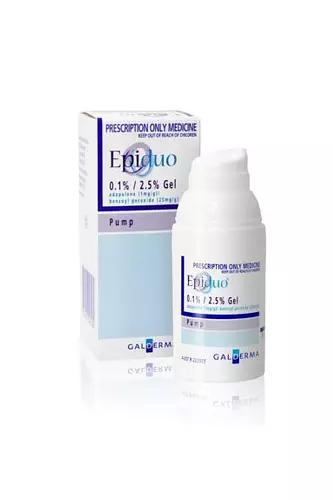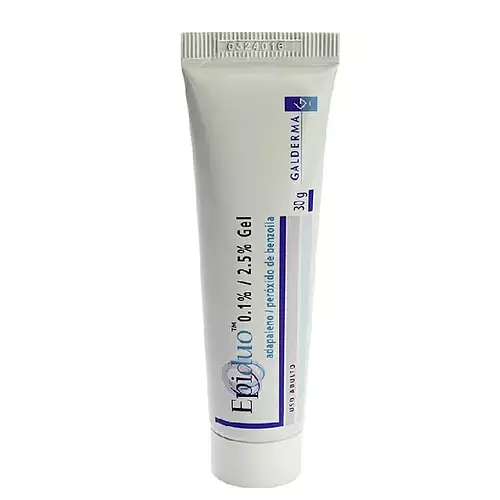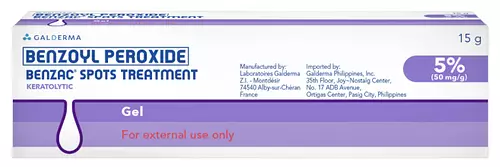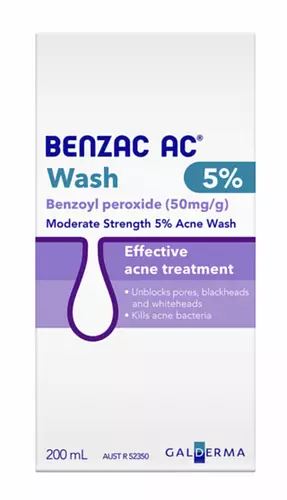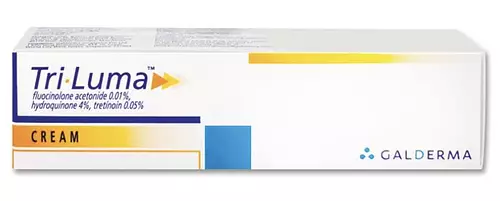
Galderma Tri-Luma Cream Ingredients Explained
Updated on February 08, 2024 Submitted by LaurenFraser_165
Overview
What it is
Prescription with 17 ingredients that contains AHA and retinoid
Suited For
It has ingredients that are good for fighting acne, anti aging, dry skin, brightening skin, reducing pores, scar healing, dark spots and better texture
Free From
It doesn't contain any harsh alcohols, common allergens, fragrances, oils, silicones or sulfates
Fun facts
Galderma is from Switzerland. This product is used in 3 routines created by our community.
We independently verify ingredients and our claims are backed by peer-reviewed research. Does this product need an update? Let us know.
Prescription with 17 ingredients that contains AHA and retinoid
Quick info
You should know
Notable Ingredients
This product contains 1 ingredient that may have this attribute:
This product contains 1 ingredient that may have this attribute:
Benefits
This product contains 1 ingredient that may have this attribute:
This product contains 1 ingredient that may have this attribute:
This product contains 1 ingredient that may have this attribute:
This product contains 1 ingredient that may have this attribute:
This product contains 1 ingredient that may have this attribute:
This product contains 1 ingredient that may have this attribute:
This product contains 1 ingredient that may have this attribute:
This product contains 3 ingredients that may have this attribute:
Concerns
This product contains 1 ingredient that may have this attribute:
This product contains 2 ingredients that may have this attribute:
This product contains 3 ingredients that may have this attribute:
This product contains 1 ingredient that may have this attribute:
Ingredients 17
Hydroquinone is used to treat hyperpigmentation, acne scars, and age spots.
Tretinoin is the best retinoid due to its proven skin benefits. It only available with a prescription in many countries.
BHT is a synthetic antioxidant. As an antioxidant, it helps your body fight off free-radicals. Free-radicals are molecules that may damage your skin cells.
Cetyl Alcohol is a fatty alcohol. Fatty Alcohols are most often used as an emollient or to thicken a product.
Citric Acid is an AHA derived from citrus fruits (think oranges, lemons, and limes!).
Glycerin is already naturally found in your skin. It helps moisturize and protect your skin.
Glyceryl Stearate is a mix of glycerin and stearic acid.
Magnesium Aluminum Silicate is a type of silica. It comes from naturally occuring minerals such as silicate ores and clay.
Methylparaben is a preservative and is a paraben. It is used to prevent the growth of fungus, mold, and other harmful bacteria. Parabens are chemicals used as preservatives in both cosmetics and food.
Peg-100 Stearate is an emollient and emulsifier. PEGS are a hydrophilic polyether compound . There are 100 ethylene oxide monomers in Peg-100 Stearate. Peg-100 Stearate is polyethylene glycol ester of stearic acid.
Propylparaben is a preservative and is a paraben with antifungal and antimicrobial properties.
Water. It's the most common cosmetic ingredient of all. You'll usually see it at the top of ingredient lists, meaning that it makes up the largest part of the product.
Sodium Metabisulfite is an antioxidant and is a preservative.
Stearic Acid is a fatty acid. It is an emollient, emulsifier, and texture enhancer.
Stearyl Alcohol is a type of fatty alcohol from stearic acid. It is a white, waxy compound used to emulsify ingredients.
Ingredient Ratings
Based on the number of likes and dislikes each ingredient has received.
Ingredients Explained
We don't have a description for Acetone.
Hydroquinone is used to treat hyperpigmentation, acne scars, and age spots.
It works by decreasing the melanocytes in your skin. Melanocytes are cells that create melanin (the color pigment in skin).
Be sure to use this ingredient as prescribed by your doctor. Wearing sunscreen is also a must (you should be wearing sunscreen anyway!).
Most hydroquinone prescriptions are not to be used for longer than 3 months.
This ingredient is banned in the EU for being skin sensitizer. In the US, this ingredient is not allowed for over-the-counter sale.
There is no known research backing this ingredient to be carcinogenic in humans.
Gentle reminder that all skin tones are beautiful!
Learn more about HydroquinoneTretinoin is the best retinoid due to its proven skin benefits. It only available with a prescription in many countries.
All forms of OTC retinoids goes through a conversion line until it can become effective. The final step of conversion is retinoic acid; retinoic acid IS Tretinoin.
This is why tretinoin is so effective; it gets to work immediately on the skin.
Research on tretinoin has found it to be incredibly effective for reducing the signs of aging. It helps improve damage from the sun, even the skin tone, and smooth out wrinkles. It is also an effective acne treatment by reducing and balancing out sebum production in pores.
Tretinoin, like other forms of Vitamin A, increases the turnover cycle of skin cells. This helps the skin create newer and healthier skin cells faster.
It can cause irritation, redness, and dry skin because it is considered a "strong" ingredient. Those with sensitive skin should consult a professional about using tretinoin.
Using retinoids will increase sun-sensitivity in the first few weeks of use. Though studies show retinoids increase your skin's natural SPF with continuous use, it is best to always wear sunscreen and sun-protection.
Read about a form of retinoid you can purchase at the store, retinol.
Learn more about TretinoinBHT is a synthetic antioxidant. As an antioxidant, it helps your body fight off free-radicals. Free-radicals are molecules that may damage your skin cells.
BHT also helps stabilize products and prevent them from degrading. Many products are sensitive to air and light. BHT prevents them from breaking down when exposed.
Cetyl Alcohol is a fatty alcohol. Fatty Alcohols are most often used as an emollient or to thicken a product.
Cetyl Alcohol is not related to SD alcohol, denatured alcohol, or ethyl alcohol. The FDA allows products labeled "alcohol-free" to have fatty alcohols.
Its main roles are:
Learn more about Cetyl AlcoholCitric Acid is an AHA derived from citrus fruits (think oranges, lemons, and limes!).
If you spot Citric Acid near the end of an ingredient list, it's likely there as a pH adjuster rather than an active ingredient.
As an AHA, Citric Acid removes the top layer of skin cells from the newer layer of skin underneath. This helps skin to remove dark spots and look more even.
Read more about some other popular AHA's here:
Learn more about Citric AcidGlycerin is already naturally found in your skin. It helps moisturize and protect your skin.
A study from 2016 found glycerin to be more effective as a humectant than AHAs and hyaluronic acid.
As a humectant, it helps the skin stay hydrated by pulling moisture to your skin. The low molecular weight of glycerin allows it to pull moisture into the deeper layers of your skin.
Hydrated skin improves your skin barrier; Your skin barrier helps protect against irritants and bacteria.
Glycerin has also been found to have antimicrobial and antiviral properties. Due to these properties, glycerin is often used in wound and burn treatments.
In cosmetics, glycerin is usually derived from plants such as soybean or palm. However, it can also be sourced from animals, such as tallow or animal fat.
This ingredient is organic, colorless, odorless, and non-toxic.
Glycerin is the name for this ingredient in American English. British English uses Glycerol/Glycerine.
Learn more about GlycerinGlyceryl Stearate is a mix of glycerin and stearic acid.
Glyceryl Stearate is used to stabilize the mixing of water and oil ingredients. By preventing these ingredients from separating, it can help elongate shelf life. It can also help thicken the product's texture.
As an emollient, it helps soften skin and supports barrier-replenishing ingredients.
In cosmetics, Glyceryl Stearate is often made from vegetable oils or synthetically produced. The human body also creates Glyceryl Stearate naturally.
Learn more about Glyceryl StearateMagnesium Aluminum Silicate is a type of silica. It comes from naturally occuring minerals such as silicate ores and clay.
Magnesium aluminum silicate is used for enhancing texture and as an absorbent. Due to its large molecular size, it is unable to be absorbed into the skin.
Like other types of silica, this ingredient can be used to thicken a product. As an absorbent, it may be used to absorb extra water or help prevent clumping.
Learn more about Magnesium Aluminum SilicateWe don't have a description for Methyl Gluceth-10.
Methylparaben is a preservative and is a paraben. It is used to prevent the growth of fungus, mold, and other harmful bacteria. Parabens are chemicals used as preservatives in both cosmetics and food.
Methylparaben can be synthetically created. It can also be found naturally in some fruits, such as blueberries.
Oftentimes, Methylparaben is combined with other parabens to help increase the shelf life.
The safety of Methylparaben is currently being studied. While ongoing studies are looking into the safety of parabens, the results have been very mixed. Some studies have not found Methylparaben to be harmful.
Learn more about MethylparabenPeg-100 Stearate is an emollient and emulsifier. PEGS are a hydrophilic polyether compound . There are 100 ethylene oxide monomers in Peg-100 Stearate. Peg-100 Stearate is polyethylene glycol ester of stearic acid.
Peg-100 Stearate helps keep skin soft by trapping moisture in. It helps prevent oil and water from separating in a product. By binding oil and water, it helps remove dirt and oil to be rinsed away.
Propylparaben is a preservative and is a paraben with antifungal and antimicrobial properties.
This ingredient can be naturally found in plants and insects, but most of it is synthetically manufactured for human use. In cosmetics, it is usually created by reacting para-aminobenzoic acid and propanol (an alcohol).
You can usually find this ingredient in water-based products.
Parabens have come under controversy due to the claim they are hormone disruptors. Studies show conflicting results. We recommend speaking with a professional if you have any concerns.
Propylparaben is commonly found in food, medicine, and cosmetics.
Learn more about PropylparabenWater. It's the most common cosmetic ingredient of all. You'll usually see it at the top of ingredient lists, meaning that it makes up the largest part of the product.
So why is it so popular? Water most often acts as a solvent - this means that it helps dissolve other ingredients into the formulation.
You'll also recognize water as that liquid we all need to stay alive. Talk about multi-purpose! If you see this, drink a glass of water. Stay hydrated!
Learn more about WaterSodium Metabisulfite is an antioxidant and is a preservative.
Stearic Acid is a fatty acid. It is an emollient, emulsifier, and texture enhancer.
As an emollient, stearic acid helps soften skin. It aids the skin's protective barrier by preventing water loss. It also provides a gentle cleansing effect without stripping away natural oils.
Stearic acid may also be used to enhance the texture of products. It can add volume and stabilize ingredients such as water and oil. This can help water and oil ingredients from separating.
Sources of stearic acid include animal or vegetable fats/oils such as coconut or shea. It can be naturally found in butter, cocoa butter, shea butter, vegetable fats, and animal tallow.
This ingredient may not be Malassezia folliculitis, or fungal-acne safe.
Learn more about Stearic AcidStearyl Alcohol is a type of fatty alcohol from stearic acid. It is a white, waxy compound used to emulsify ingredients.
Fatty Alcohols are most often used as an emollient or to thicken a product. Emollients help soothe and hydrate the skin by trapping moisture.
They are usually derived from natural fats and oils and therefore do not have the same drying or irritating effect as solvent alcohols. FDA allows products labeled "alcohol-free" to have fatty alcohols.
Learn more about Stearyl AlcoholWhen to use
How this product is used by our community
Directions
Apply Tri-Luma® Cream at night, at least 30 minutes before bedtime.
Gently wash your face with a mild cleanser. Don’t use a washcloth to apply the cleanser, just your fingers. Rinse and pat your...
Apply Tri-Luma® Cream at night, at least 30 minutes before bedtime.
Gently wash your face with a mild cleanser. Don’t use a washcloth to apply the cleanser, just your fingers. Rinse and pat your skin dry.
Put a small amount (pea sized or ½ inch or less) of Tri-Luma® Cream on your fingertip. Apply a thin coat onto the discolored spot(s). Include about ½ inch of normal skin surrounding the affected area.
Rub the medicine lightly and uniformly into your skin. The medicine should become invisible almost at once. If you can still see it, you are using too much.
Keep the medicine away from the corners of your nose, your mouth, eyes and open wounds. Spread it away from those areas when applying it.
Do not use more Tri-Luma® Cream or apply it more often than recommended by your doctor. Too much Tri-Luma® Cream may irritate your skin and won’t give you faster or better results.
Do not cover the treated area with anything after applying Tri-Luma® Cream.
You may also use a moisturizer and cosmetics during the day.
More Galderma Products
See all Galderma productsMore Prescription
See all prescriptionWe're dedicated to providing you with the most up-to-date and science-backed ingredient info out there.
The data we've presented on this page has been verified by a member of the SkinSort Team.
Read more about us

